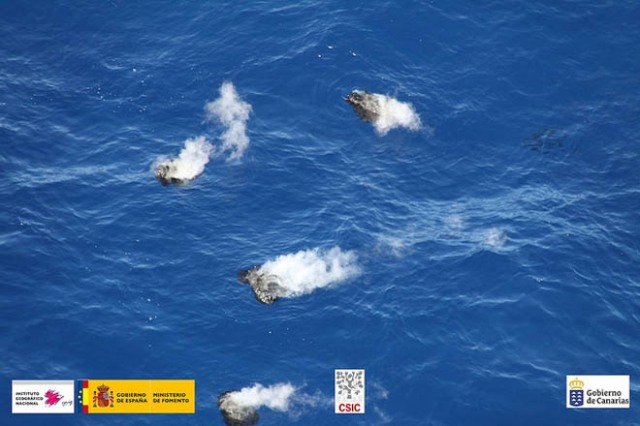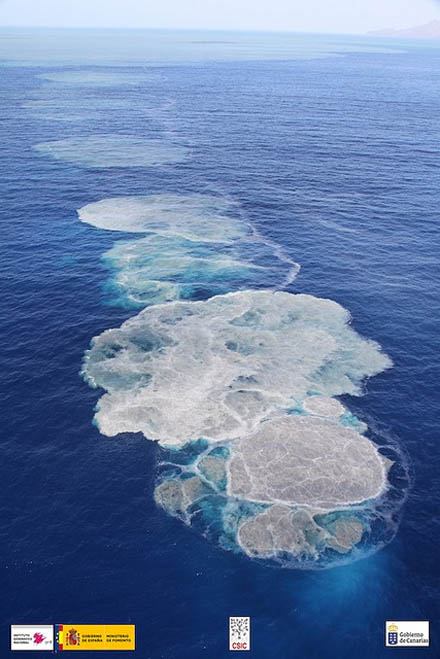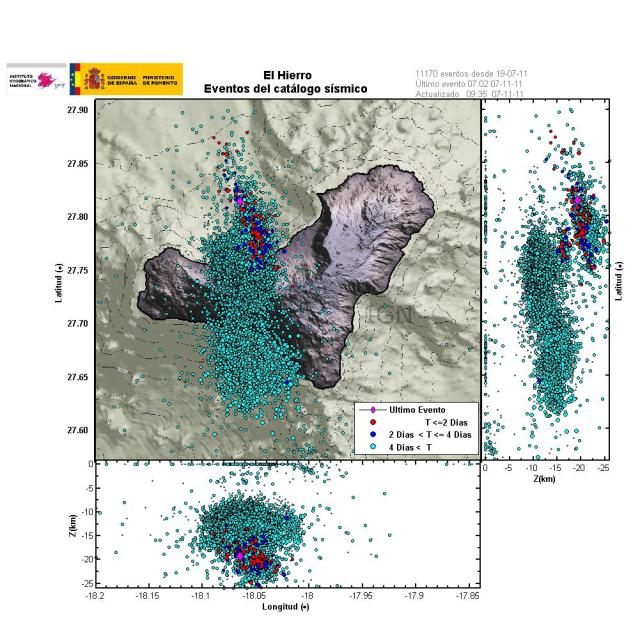UPDATED 16:40
The eruption at El Hierro has (as of Saturday) become at least partially subaerial. For the non-scientists amongst you that means that the submarine eruptions over the last month or so have built up enough material that eruption is now occurring at the surface. Ladies and gentlemen – prep the suncream – we very nearly have a new Canary island. Thomson are no doubt already trying to work out how to land a plane on it, while real estate agents are presumably at this very moment submitting planning applications for towering hotel complexes.
A few other nice pics have surfaced too – The first is another example of floating steaming pumice/scoria:
And a lovely shot down a series of roiling surfaces, related to a chain of submarine vents – presumably the submarine equivalent of a fissure eruption.
There’s a really lovely series of images of the pumice/scoria pieces which have been recovered, available on this Flickr set.
The seismic activity is still occurring in the deeper Northern region, at between 15-24km depth. It’s worth mentioning that in an oceanic setting that’s really quite impressively deep. In fact this activity at El Hierro is likely to add new fuel to the ongoing (and largely unresolved) debate about what the mechanism is for Canary volcanism.
The issue at the Canary islands is that while the islands might at first seem prime candidates for hotspot-type activity, they do not show the younging-direction typical of a ‘normal’ hotspot chain. For example, the Hawaiian hotspot chain clearly has an active young end, an old extinct end, and a nice neat chain between. In the Canary islands you have no chain – more of a cluster – and there’s recent activity at numerous locations with no clear pattern. There’s no subduction near by, and there’s no spreading ridge so the three well understood causes of volcanism don’t seem to apply.
On top of that you have some weird chemistry. The first analyses are coming in from the new vent, and suggest there’s two different magmas present – one low silica basanite (like basalt), the other high silica trachyte/rhyolite. Like other Canary magmas – they appear to be high in sodium and potassium (what are known as alkali) minerals.
For these two very different magmas to co-exist, we probably have (at least) two independant magma chambers; the basalt/basanite magma is primitive and will have originated as a mantle melt which then rose quickly. The more evolved trachyte/rhyolite magma requires lots of segregation to form. That means it has to sit in a magma chamber for a long time so gradual crystallisation is able to remove low-silica minerals such as pyroxene and olivine, resulting in a residual melt enriched in silica.
It will be interesting to see if any subsequent work can tie together the seismic activity to eruptive material, and hence map where the two magma systems reside.
Over the next few days I’m going to put together a piece on Tenerife – one of the adjacent islands which also demonstrates a bimodal alkali magma system.
All seismic plots are courtesy of IGN.
UPDATE:
Awesome new image released. A thermal camera shot of one of the ‘jacuzzi’ spots. Bare in mind that peak temperature on the scale displayed there is 35.9 degrees C. Although I imagine that changes pretty rapidly with depth…









Exciting images and information. Thanks!